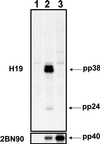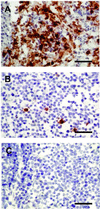Rescue of a pathogenic Marek's disease virus with overlapping cosmid DNAs: use of a pp38 mutant to validate the technology for the study of gene function
- PMID: 11997455
- PMCID: PMC124527
- DOI: 10.1073/pnas.092152699
Rescue of a pathogenic Marek's disease virus with overlapping cosmid DNAs: use of a pp38 mutant to validate the technology for the study of gene function
Abstract
Marek's disease virus (MDV) genetics has lagged behind that of other herpesviruses because of the lack of tools for the introduction of site-specific mutations into the genome of highly cell-associated oncogenic strains. Overlapping cosmid clones have been successfully used for the introduction of mutations in other highly cell-associated herpesviruses. Here we describe the development of overlapping cosmid DNA clones from a very virulent oncogenic strain of MDV. Transfection of these cosmid clones into MDV-susceptible cells resulted in the generation of a recombinant MDV (rMd5) with biological properties similar to the parental strain. To demonstrate the applicability of this technology for elucidation of gene function of MDV, we have generated a mutant virus lacking an MDV unique phosphoprotein, pp38, which has previously been associated with the maintenance of transformation in MDV-induced tumor cell lines. Inoculation of Marek's disease-susceptible birds with the pp38 deletion mutant virus (rMd5 Delta pp38) revealed that pp38 is involved in early cytolytic infection in lymphocytes but not in the induction of tumors. This powerful technology will speed the characterization of MDV gene function, leading to a better understanding of the molecular mechanisms of MDV pathogenesis. In addition, because Marek's disease is a major oncogenic system, the knowledge obtained from these studies may shed light on the oncogenic mechanisms of other herpesviruses.
Figures





References
-
- Churchill A E, Biggs P M. Nature (London) 1967;215:528–530. - PubMed
-
- Nazerian K, Solomon J J, Witter R L, Burmester B R. Proc Soc Exp Biol Med. 1968;127:177–182. - PubMed
-
- Calnek B W, Witter R L. In: Diseases of Poultry. Calnek B W, Barnes H J, Beard C W, McDougald L R, Saif Y M, editors. Ames, IA: Iowa State Univ. Press; 1997. pp. 369–413.
-
- Churchill A E, Chubb R C, Baxendale W. J Gen Virol. 1969;4:557–564. - PubMed
-
- Okazaki W, Purchase H G, Burmester B R. Avian Dis. 1970;14:413–429. - PubMed
MeSH terms
Substances
LinkOut - more resources
Full Text Sources
Other Literature Sources

